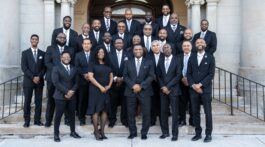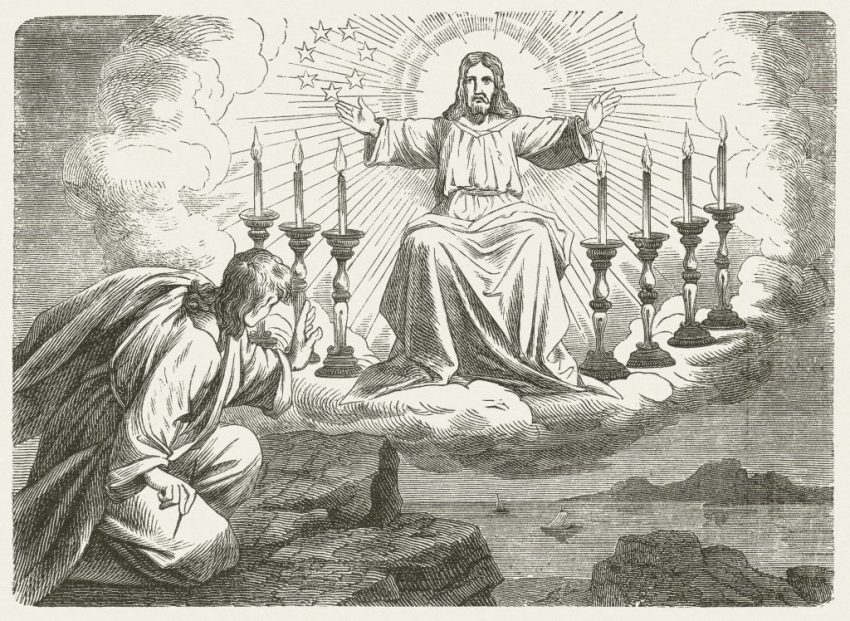Sabbath School Lesson for January 5-11, 2019
Overview
Our lesson this week brought out information pertaining to…
- what it was like for John on the island of Patmos, when he received visions and was told to record them (Sunday)
- what it meant for the vision to come to John on the Lord’s Day, and which day that was referring to (Monday)
- what Christ looked like in the vision, and what His appearance tells us about Him (Tuesday)
- what past and future applications might be derived from the messages to the seven churches (Wednesday)
- what message was given to the first church in Ephesus and how does it accurately portray the church of John’s day in the first century (Thursday)
Introduction
John begins his record of the vision he received by describing for us what Christ looked like in the heavenly sanctuary. Only at the transfiguration had Jesus been so gloriously portrayed to John. One of his last remembrances of Him was after His resurrection, when He showed His disciples the scars from the nails in His hands and side (John 20:20).
As John introduces us to the Messiah in this setting so familiar to his Jewish peers, we share with them a calm assurance that this is the One who has the “keys of Hades and of Death” (Revelation 1:18 NKJV). Like David and other prophets of the Old Testament who had similar visions, we, along with John, derive peace and comfort from this heavenly divine Being.
David, as a matter of fact, was inspired to write about how close he felt to God in the sanctuary. See Psalm 73. The holy place of God helped him to understand much of what was wrong in the world–why sinners seem to prosper and God’s children are left to suffer trials. Salvation from this world of sin are symbolically represented in the ceremonies of God’s temple, and understanding is possible when we search for God there.
Memory Text:” ‘He who has an ear, let him hear what the Spirit says to the churches.’ “ Revelation 2:7 NKJV
Along with the Lord Jesus Christ, clothed as the High Priest of the heavenly sanctuary, we are reminded that the Holy Spirit also has a part in John’s story. He’s the One who speaks messages to the seven churches.
Starting with Ephesus, we begin our church history lesson with the first-century church to which John belongs. Next week, we will continue the story and examine the other six church messages, and see how the church is portrayed in history, right down to God’s final-day people.
Sunday: On Patmos
John’s exile to Patmos was no “island vacation”. This tiny piece of land (only ten miles long and six miles wide) served as a penal colony for criminals and political enemies of Rome. There, Roman guards kept them in chains, no doubt provided them with little food, and enforced long hours of hard labor. Imagine a ninety-year-old man like John enduring such harsh conditions.
It was in this discouraging setting that John’s faith was renewed and he was given the courage to continue his life of hardship and toil. The first portrayal of Christ given to John must have lifted his spirits and thrilled his heart.
John was reminded of others who had gone before him, such as Daniel and his friends in their Babylonian captivity and even the more recent stoning of Stephen, the first Christian martyr. This vision and revelation of God would be enough to sustain him through any hardship the future might hold for him on Patmos.
Discussion Questions:
Read Revelation 1:9. Why was John suffering on Patmos? Why is it important for us to know where he was when John wrote his story?
Read Daniel 3:16-23. Why did it not matter to Daniel’s friends if they were delivered from this punishment or not? On what should our obedience be based?
Read Acts 7:54-60. For what purpose was Stephen not delivered from those who stoned him? Why are we sometimes not set free from our own trials and hardships?
Monday: On the Lord’s Day
Many have used the verse–Revelation 1:10–as confirmation of Sunday worship. After all, the term “Lord’s Day” is now commonly used to refer to Sunday, the first day of the week. But did John receive the vision on Sunday, or on the previously-kept Jewish Sabbath?
Historians tell us that Sunday worship, and the term the Lord’s Day for that day, did not come about til well after John’s lifetime. Therefore, despite the fact that Sabbath is not called the Lord’s Day anywhere else in Scripture, we must assume that John was speaking of the seventh-day Sabbath when he gave the time and place of his vision.
After all, the Old Testament frequently refers to the Sabbath as belonging to God. And Jesus Himself is quoted in the Gospels as saying, “the Son of Man is Lord…of the Sabbath” (Matthew 12:8, Mark 2:27, 28, and Luke 6:5). Therefore, to John, the seventh-day Sabbath would be the Lord’s Day, a day belonging to Him.
One might note that the Day of Judgment at the end of time is also referred to as “the day of the Lord”. See Isaiah 13:6-13 and 2 Peter 3:10. But, in context, John was not be referring to that event in the first chapter of Revelation.
The Lord’s Day to John would be none other than the weekly Sabbath that he was accustomed to all his life. John had always felt particularly close to God on that day, as the day was designed. We shouldn’t be surprised that this special closeness with God led to his receiving visions there on Patmos on that blessed Sabbath day.
Interestingly, Jews have treasured the Sabbath as a foretaste of heaven. John was getting an ample dose of heaven on that momentous Sabbath when he received this spectacular glimpse of Jesus in the heavenly sanctuary.
Discussion Questions:
Read Revelation 1:10 and Exodus 20:8 and 31:13. Why would John have been among those who continued to keep the seventh-day Sabbath as a special time to spend with God? What was God’s purpose in blessing the seventh day of the week?
Read Exodus 20:11 and Deuteronomy 5:15. Why is the Sabbath not just a reminder of how we were created and who our Creator is? What other event in the life of every sinner does the Sabbath remind us?
Read Isaiah 13:9 and 2 Peter 3:10. Why would this “day of the Lord” not be “the Lord’s Day” on which John received his vision?
Tuesday: John’s Vision of Christ on Patmos
John’s description of this heavenly being in the first chapter of Revelation sounds strikingly similar to the being Daniel saw in vision (Daniel 10:5, 6). It definitely sounds like someone dressed like a High Priest, which makes us realize the setting must be in the sanctuary above. Hebrews 9:24 says…
“For Christ has not entered the holy places made with hands, which are copies of the true, but into heaven itself, now to appear in the presence of God for us;” NKJV
The heavenly Being identifies Himself to John quite clearly as being Jesus Christ, the One who lives, was dead, and is alive forevermore. He even proceeds to explain what John is witnessing and about to hear. He gently says all the right things to ease the fear and confusion John must be experiencing at the start of his vision.
The seven stars that Jesus held in His right hand represented angels of seven churches, which were each to deliver a message to the churches. The lampstands stood for those churches, reminding us that we are to be a light to the world (Matthew 5:14).
Discussion Questions:
Read Revelation 1:11 and Isaiah 44:6. How do these verses confirm that Jesus is God, part of what we now call the Trinity?
Read Revelation 1:12-16, Daniel 10:5, 6, and 3:25. How did Nebuchadnezzar recognize the fourth being walking around in the fire as the Son of God? Why did God entrust this pagan king with such an important vision (see chapter 2), when He could have given it directly to Daniel? Why was John so blessed with the vision, and not the other disciples?
Read Revelation 1:17-18 and John 10:17, 18. What gives Jesus the right to claim the keys to death and hell? Has anyone else ever been resurrected by their own power?
Wednesday: Christ’s Messages for Then and Now
Christ’s messages to the seven churches are valuable to us on many levels. Prophesying about the church, God’s people, would be the best approach for this communication, because, as humans, we are naturally drawn to predictions or evaluations that involve us.
It is interesting to see ourselves through these messages–involving past, present, and (for John) future happenings. So, let’s consider the many applications this vision has for us.
- There’s the historical application. The seven churches called out in this vision were actual churches in Asia at the time. Emperor worship was becoming so popular in the Roman Empire that persecutions were becoming harsher and more unbearable. These churches, both individually and collectively, would have benefited from these messages of counsel and encouragement.
- There’s the prophetic application. Each of these churches, from a prophetic standpoint, stood for succeeding periods of church history throughout the years that followed John’s lifetime. Being familiar with these historical periods helps us know that God is behind the vision and in control of events that affect the church.
- There’s the universal application. There are lessons of value in this vision that empower God’s people everywhere and at any time. People living today, in what might be the Laodicean period, are just as apt to see themselves described by some of the other churches’ characteristics. It serves as a reminder that no matter what our spiritual condition is currently, we are edified by Christ’s presence and motivated to mature and become more like Him.
Discussion Questions:
Read Revelation 1:19. How does this verse reveal that there are many ways to learn from the vision?
Read Revelation 1:20, Matthew 5:14, and John 1:7-9. How does God’s church serve as a lampstand for God’s messages?
Read Revelation 22:16. The number seven is the most frequent number found in Bible prophecy. Why do you think this is so? What does it represent?
Thursday: Message to the Church in Ephesus
Paul’s letter to the Ephesians gives us a glimpse into the first church of John’s vision. At the time Ephesus was the capital and largest city in Asia, then a Roman province. Being such a diverse, pagan population guaranteed a fight against immorality and superstition. But Paul says in Ephesians 1:15 that “I have heard of your faith in the Lord Jesus and your love for all the saints.”
This description aptly fits the early church of the apostles from A.D. 31-100. As time went on, they had more and more persecutions to contend with, requiring a great amount of faith to endure them. We also know how much they loved God, and how giving they were to each other. Even selling their properties to support those less fortunate in their midst.
The Angel John saw in vision spoke of the Ephesians, saying “I know your works, your labor, your patience.” He also commended them for searching for the truth, not allowing evildoers and liars to influence them.
This first church period then (the apostolic church) was obviously a pure, truth-filled movement, with an enormous amount of love for their Lord. But the Angel proceeded to describe a loss of that love and its detrimental effect on the church. The church at Ephesus was warned to return to that love by repenting.
Eternal life was promised to those who were overcomers (Revelation 2:7). We today must also repent and overcome sin, so we can eat from the tree of life when we get to heaven.
Discussion Questions:
Read Revelation 2:2-3 and Ephesians 1:15. Why was patience and perseverance needed during the first-century church, not just in Ephesus?
Read Revelation 2:4, 5. Why is there a tendency to lose our first love for Christ after we’ve been in the church for awhile? What measures can be used to stop this from happening?
Read Revelation 2:6, 7. Why is our reward of eternal life perhaps our most crowning achievement as members of the human race? How and when will we attain it?
And Finally…
This miraculous encounter with Jesus in vision, alarming as it was to John at first, must have later been a great comfort to him, in his present, miserable condition of exile on Patmos.
Let’s continue to learn Psalm 91, and we too can experience peace and tranquility, despite any adverse situation we might face on this earth.
“He who dwells in the secret place of the Most High shall abide under the shadow of the Almighty. I will say of the Lord, “He is my refuge and my fortress; my God, in Him I will trust.” Psalm 91:1, 2 NKJV
Oh, how John must have thrilled at the thought of this passage in Scripture. God was his fortress and refuge indeed on that lonely, desolate island. Let’s trust Him as well, no matter what trying circumstance we face.
Next Week’s Lesson: Jesus’ Messages to the Seven Churches
To read the Sabbath School Lesson Quarterly or see more resources for its study, go to https://www.absg.adventist.org/
Other Outlook blogposts by Teresa Thompson, are at http://outlookmag.org/author/teresathompson/










